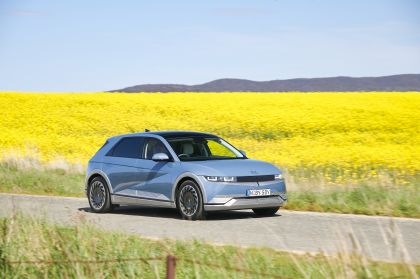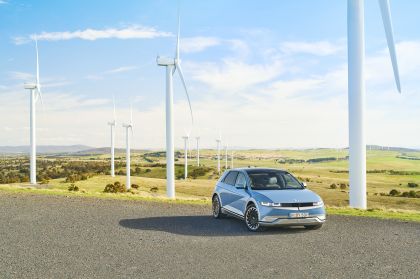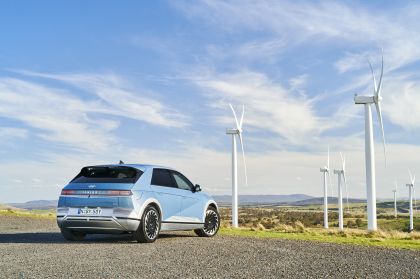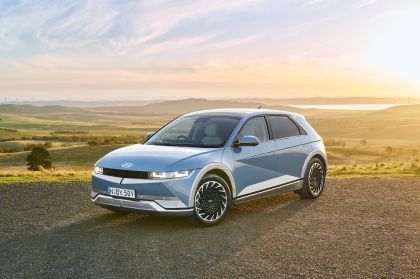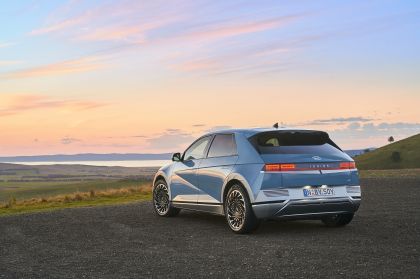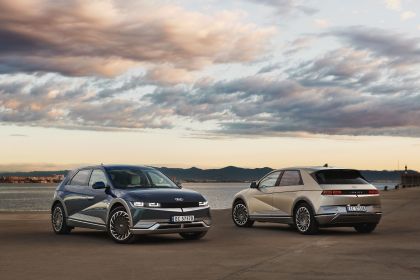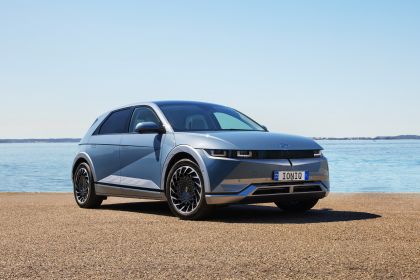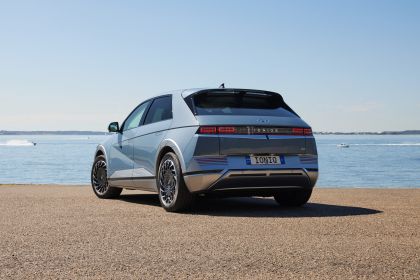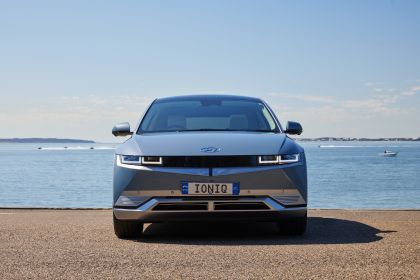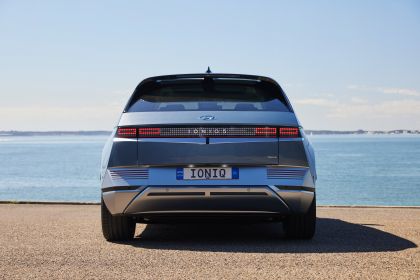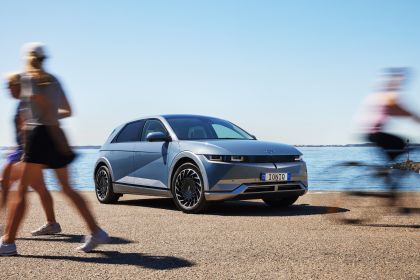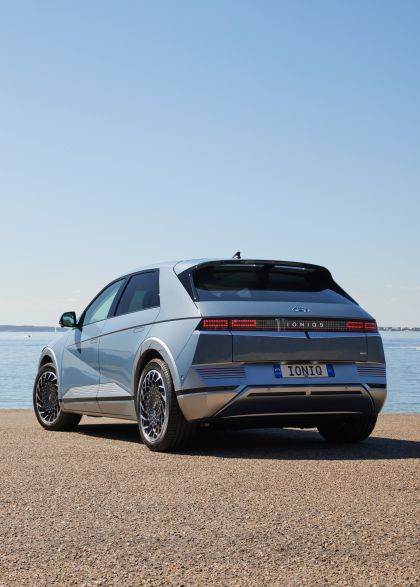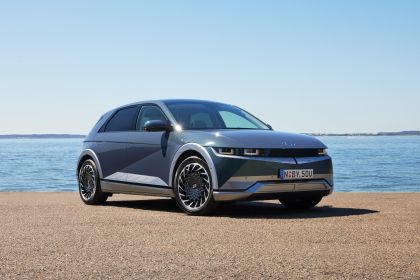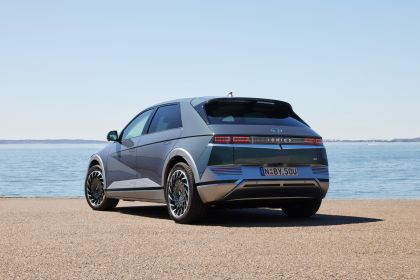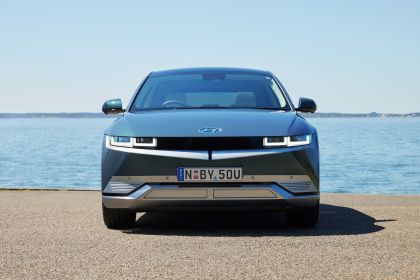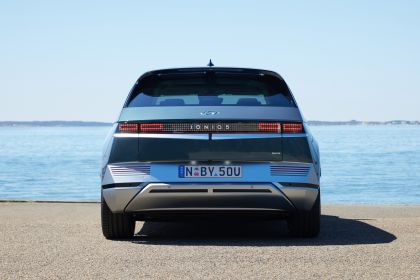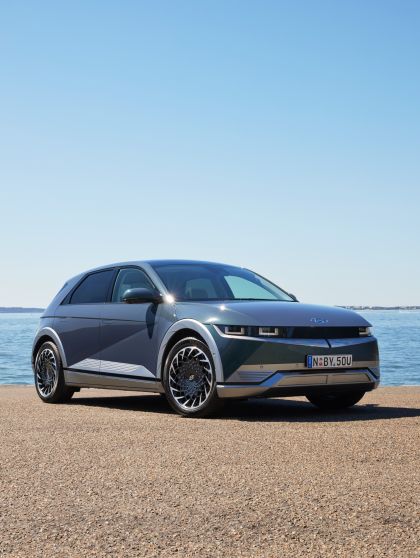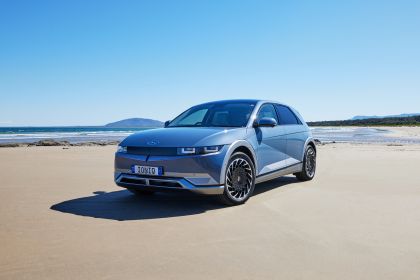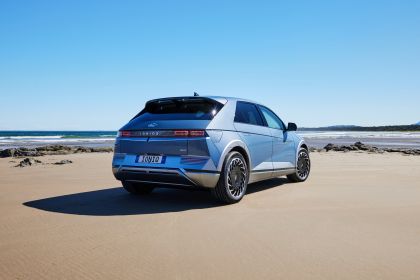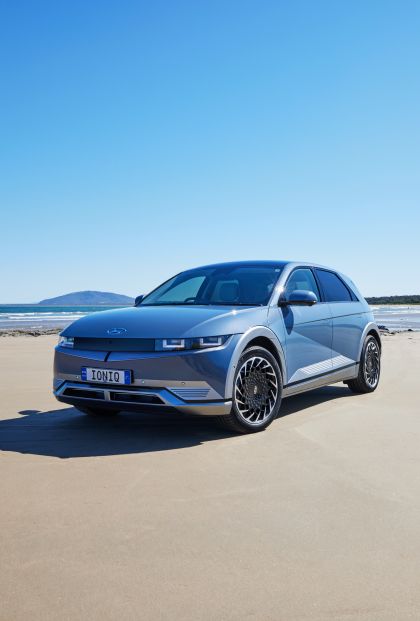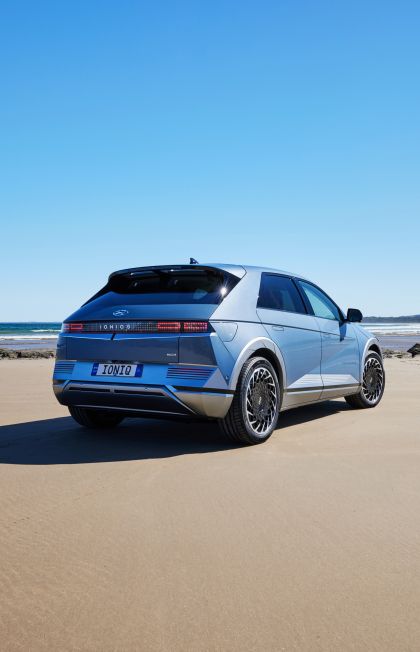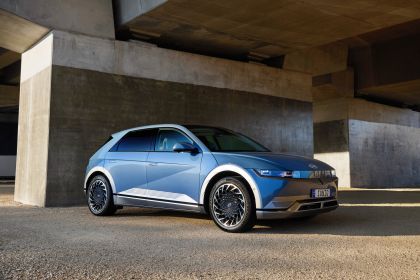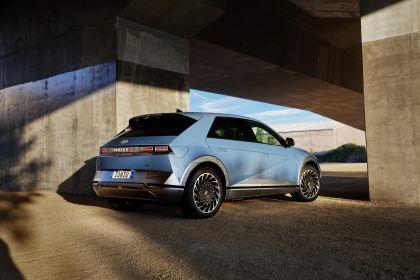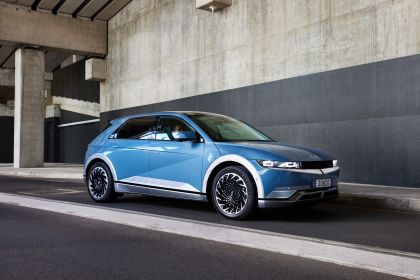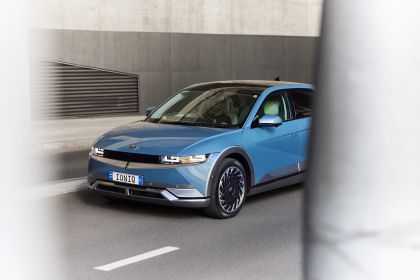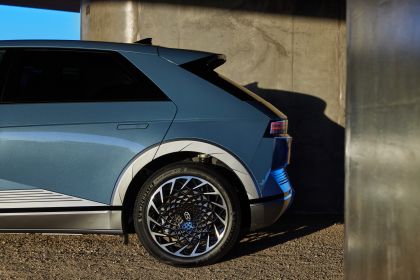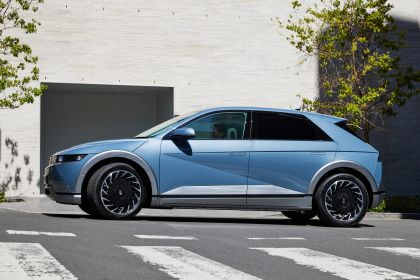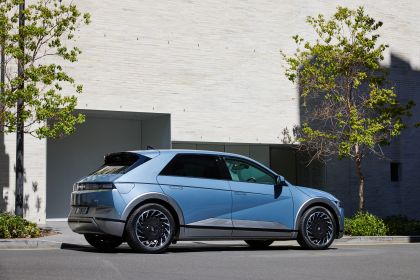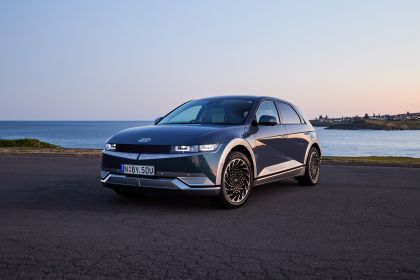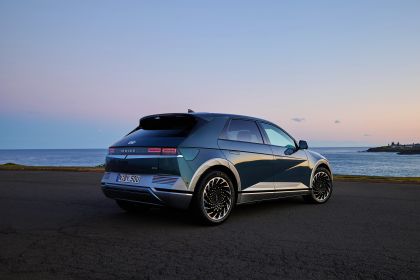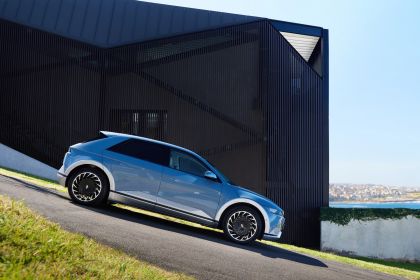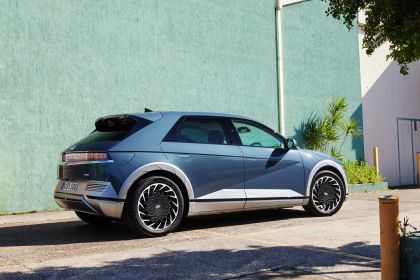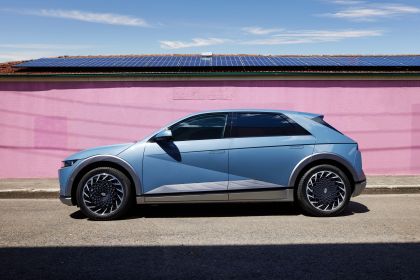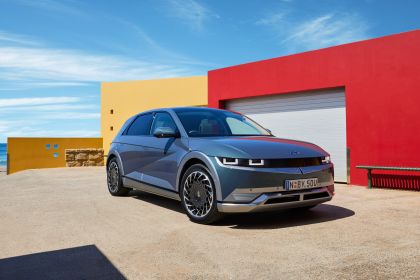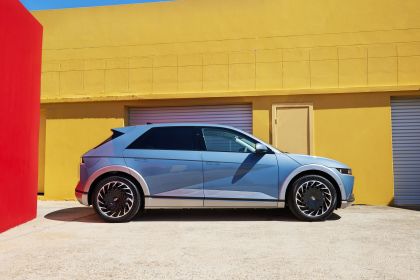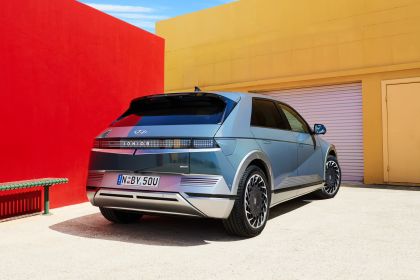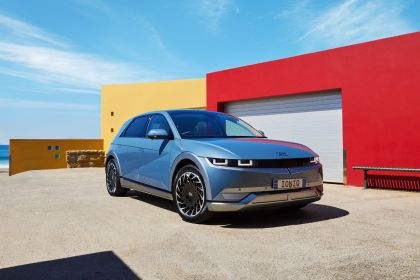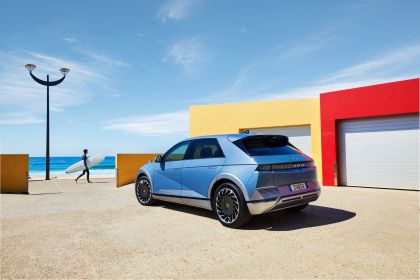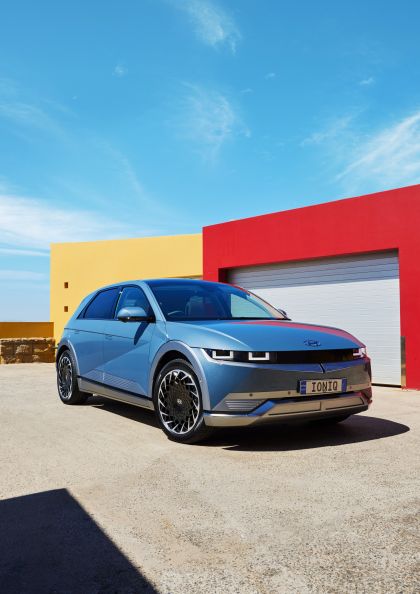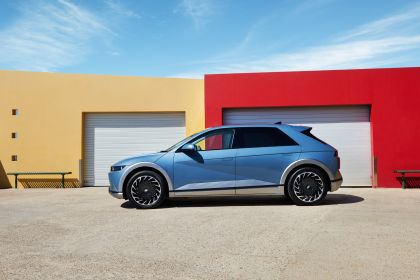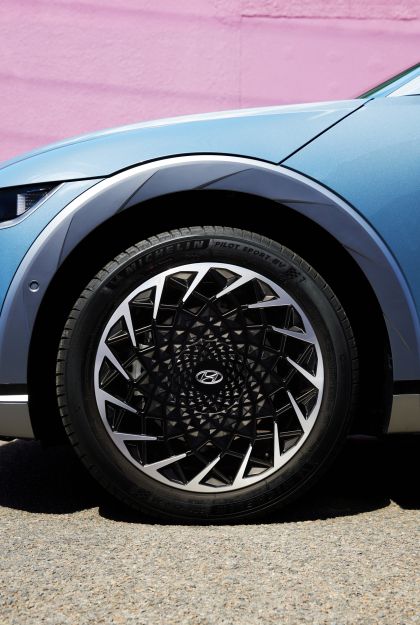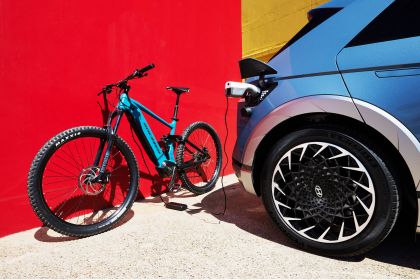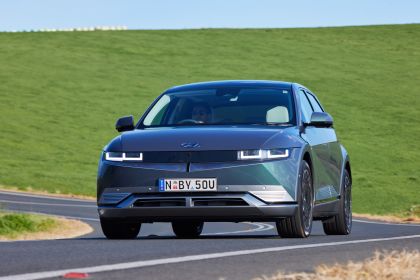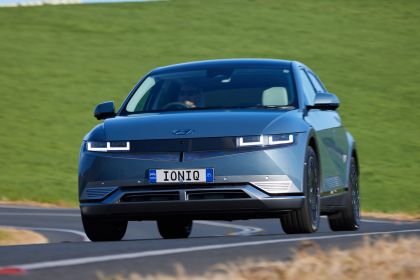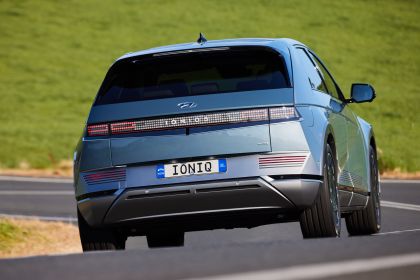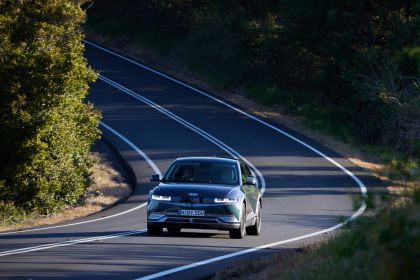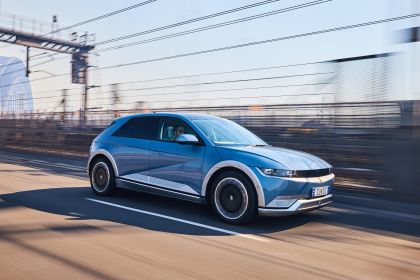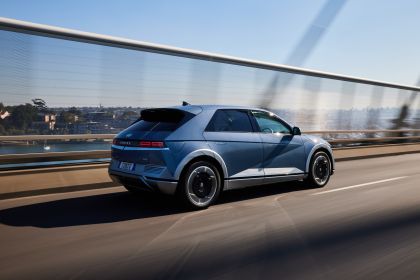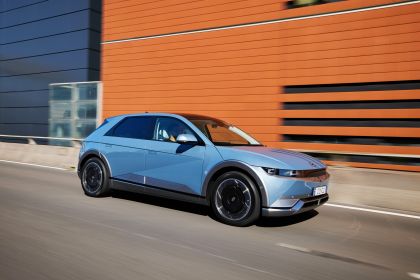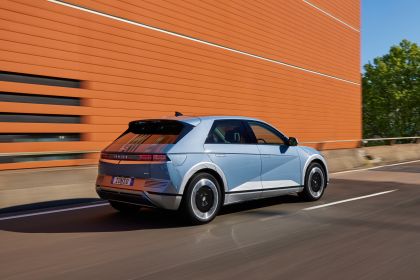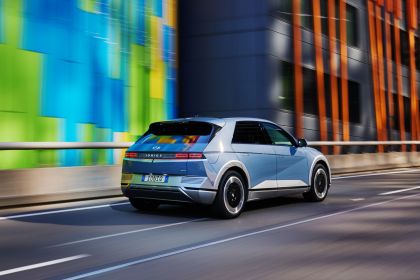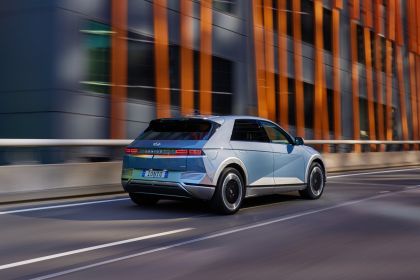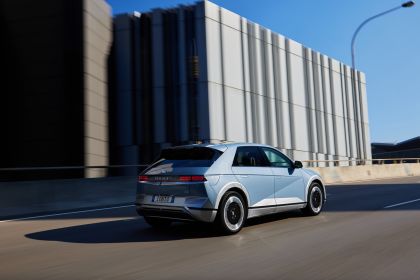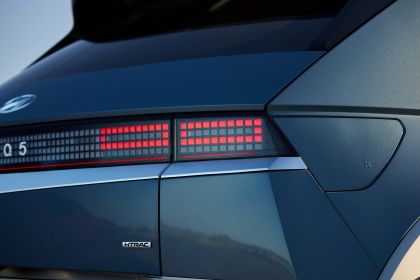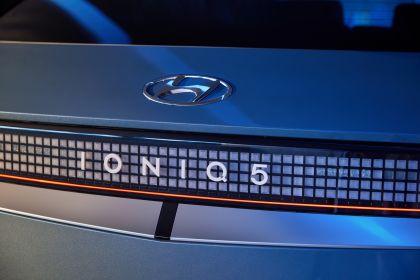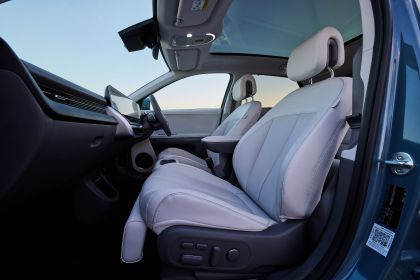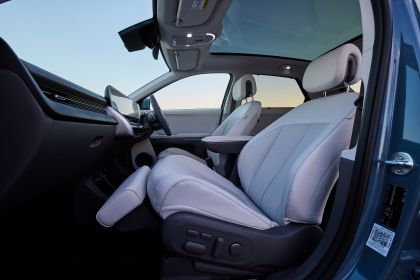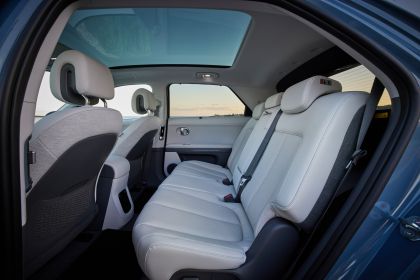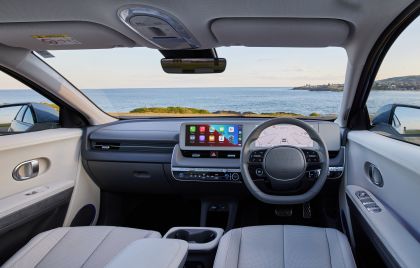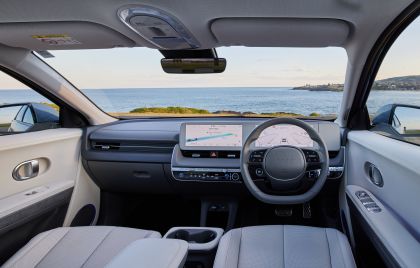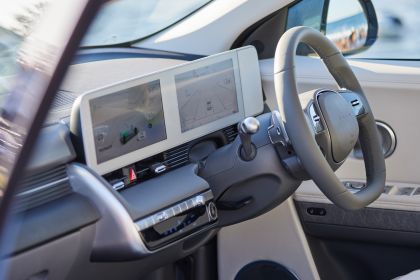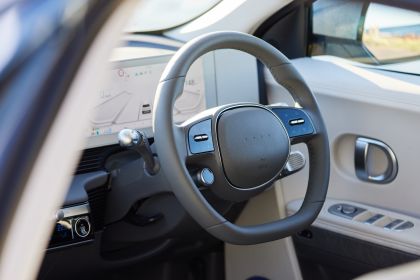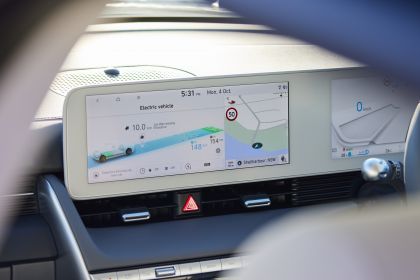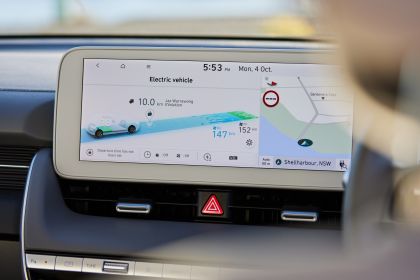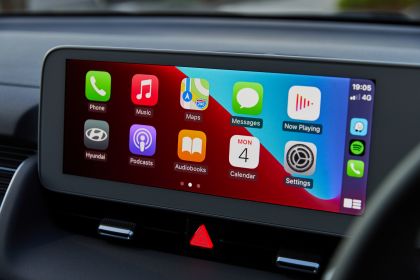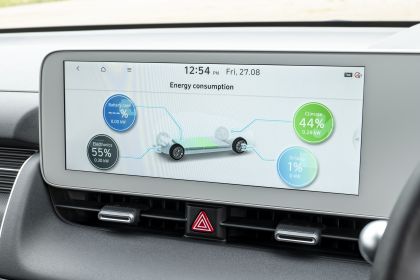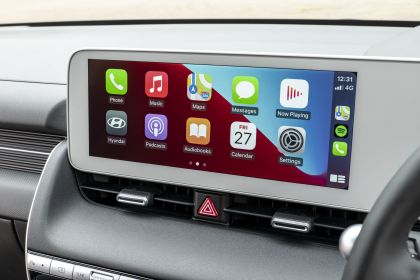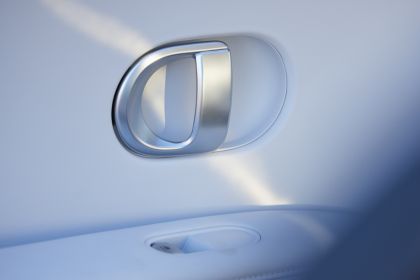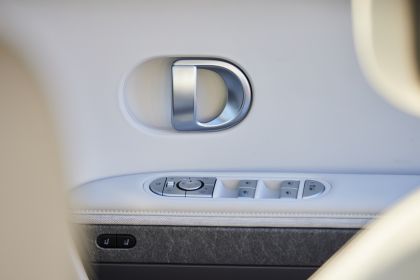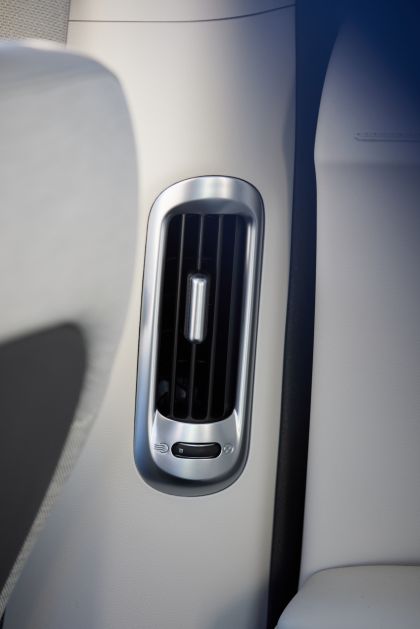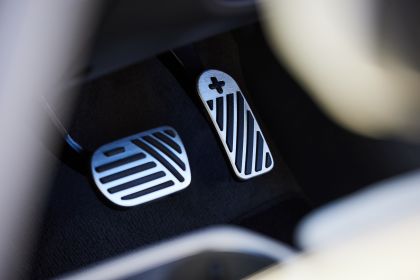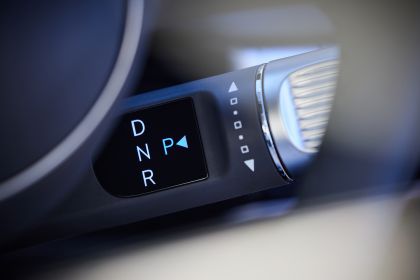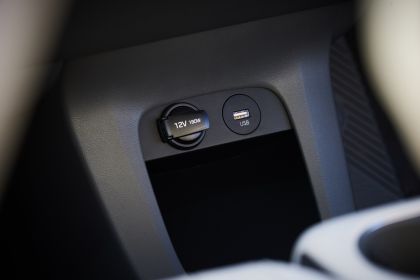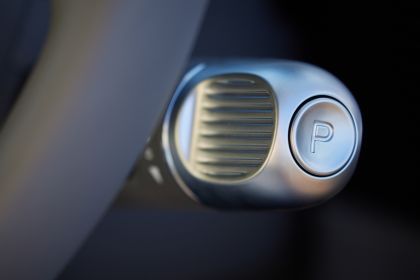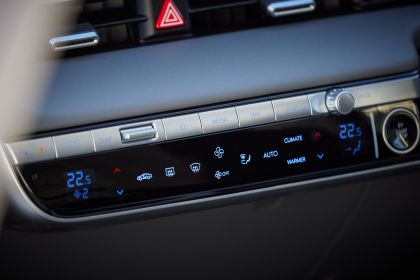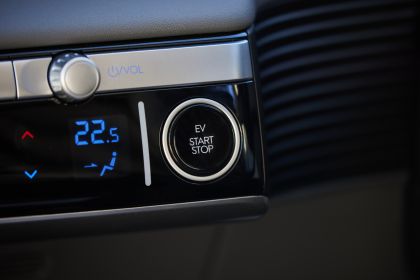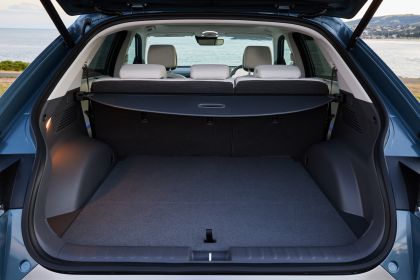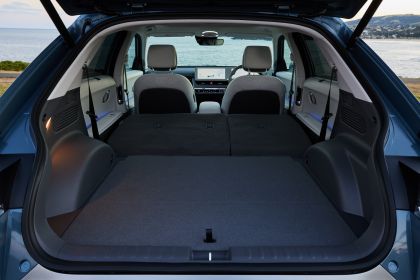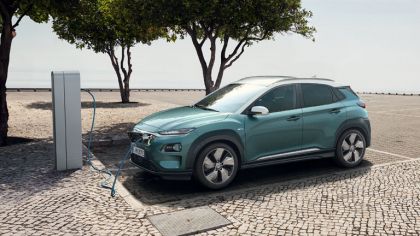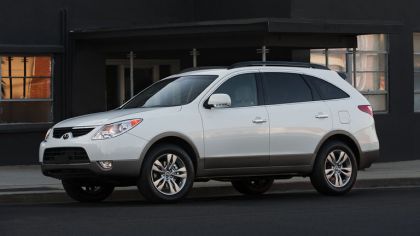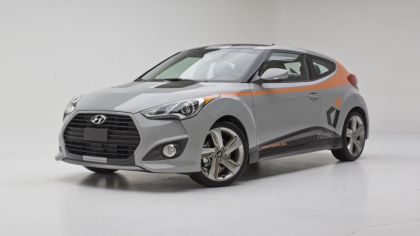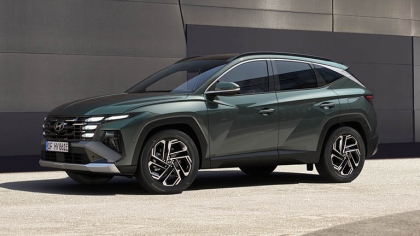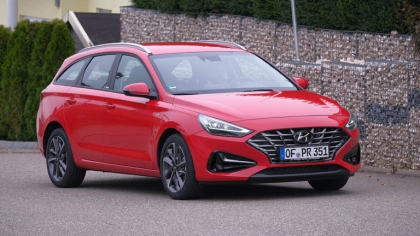IONIQ 5, Hyundai's first-ever dedicated battery-electric model, which redefines the EV lifestyle through innovative and sustainable design.
Built on Hyundai's dedicated Electric-Global Modular Platform (E-GMP), IONIQ 5 makes the most of the architecture's design freedoms with its unique proportions and spacious, flexible and fully-featured interior.
Strong pure-electric performance and world-first patented ultra-fast 400V and 800V charging make IONIQ 5 a uniquely appealing EV proposition, while a Vehicle-to-Load (V2L) function gives customers essentially a powerful mobile charger on wheels.
IONIQ 5 is available in one flagship grade, with the option of a 2WD, rear-driven motor layout, or a dual motor (rear & front) HTRAC AWD layout.
Every IONIQ 5 provides the safety of seven airbags and features an extensive suite of SmartSenseTM advanced active safety and driver assistance technologies.
A 12.3-inch digital instrument cluster is the headline in the cabin, along with a 12.3-inch Multimedia navigation unit featuring Android Auto/Apple CarPlay smartphone compatibility and a BOSE eight-speaker premium audio system.
Luxuries include seats trimmed in sustainable eco-processed leather, 12-way power front seats with 'Relaxion' (zero gravity) mode & memory function, and two-way power rear seats (60/40) with memory.
There is also a heated steering wheel, heated and ventilated front seats, heated rear seats, a vision glass roof with power sunshade, and a smart power tailgate.
LED headlights, front guide lights and taillights, and striking 20-inch alloy wheels complement IONIQ 5's progressive style to create an attractive, high-tech image.
Smart regenerative braking, a safety-enhancing Virtual Engine Sound System (VESS) and an 'i-Pedal' mode for one-pedal driving, allows customers to enjoy the full benefit of IONIQ 5's progressive powertrain.
Every IONIQ 5 features a 653V high-voltage lithium-ion polymer battery as the power source for a dynamic electric vehicle experience.
EXTERIOR
A striking, aerodynamic fastback body profile heralds IONIQ 5's game-changing EV powertrain and uniquely versatile cabin.
A futuristic reinterpretation of the 1974 Pony concept car - Hyundai's first passenger car - IONIQ 5's form underpins immense cabin space and provides slippery aerodynamics (Cd is 0.288) to help maximise the efficiency of the battery-electric powertrain.
IONIQ 5's aerodynamic fastback silhouette applies the Parametric Dynamics design language and is enhanced by gloss black window and mirror trims, liquid metal painted cladding and flush type power door handles.
A hidden charging port at the rear on the driver's side promotes convenience and complements IONIQ 5's high-tech image. An LED Parametric Pixel charging indicator provides a visual gauge of charging status.
Parametric Pixel LED headlights and a hidden LED garnish headline IONIQ 5's distinctive frontal styling, with an aluminium clamshell bonnet, and a drag-reducing active air flap in the lower intake lending a clean aerodynamic look.
A vision glass roof above and Parametric Jewel aerodynamic wheels, pushed to the corners courtesy of a long 3000mm wheelbase, complete IONIQ 5's profile.
An aerodynamic rear spoiler featuring dual rectangular openings reflects Hyundai's Sensuous Sportiness design philosophy, while improving airflow characteristics, and is teamed with slice reflectors and Parametric Pixel full LED rear lights contribute to a sporty and futuristic stance.
Full LED lighting
Dual-projector LED headlights showcase Parametric Pixel graphics while providing exceptional illumination, and feature bright integrated LED DRLs, positioning lights and turn signals.
In addition, a full width lower garnish showcases an array of hidden LED lighting that operates in conjunction with the LED positioning lights.
IONIQ 5's LED taillights incorporate positioning, brake light, turn signals, reverse and fog lights all with the high-tech signature Parametric Pixel design.
These are paired with an LED light guide that runs the width of the vehicle, operating in conjunction with the positioning lights.
The lower bumper houses LED number plate lights and the slice-effect reflectors, which provide a nostalgic nod to 1980s electronics.
High-mounted stop lights in the rear spoiler feature a twin array of rectangular LEDs that carry forward the design heritage of the original Hyundai Pony.
INTERIOR
IONIQ 5's 'Smart Living Space' interior theme maximises occupant space and versatility while showcasing an abundance of premium, soft-touch eco finishes creating a lounge-like contemporary ambience.
Panoramic view twin 12.3-inch displays headline IONIQ 5's modular driver cockpit, bringing together all the driving & operating information in an intuitive and high-tech layout.
IONIQ 5's dedicated E-GMP platform frees under-bonnet space compared with a conventional platform, which allows some HVAC components to be relocated out of the cabin, in turn allowing for a slim dashboard that opens up more front occupant space, as well as a generous drawer-type glovebox that holds up to 9.4 litres.
The dedicated electric platform also allows for a long wheelbase and a flat floor, increasing legroom and enhancing the overall sense of openness and space in the cabin.
A versatile 'Universal Island' adjustable centre console slides up to 140mm fore and aft to allow front or rear passengers to enjoy more space as required, as well as providing for all USB connectivity and storage needs.
A power sliding rear seat function can increase second-row legroom or luggage space by up to 135mm, enhancing overall flexibility.
Cargo
IONIQ 5's generously sized 527-litre rear cargo compartment was designed around commonly carried items such as strollers, suitcases and golf bags. With the 60:40 second-row backrests folded flat; the space expands to 1587 litres.
The rear cargo compartment is also equipped with a dual-position retractable cargo cover, a luggage net with four tie-down hooks and an underfloor storage compartment, with a solid-type luggage board cover that folds and has its own storage slot.
The packaging benefits of the rear-wheel-drive-based E-GMP platform along with AWD variants' low-profile front motor assembly frees space for an additional cargo compartment at the front (a Hyundai first).
It offers up to 57 litres of storage (2WD powertrain) or 24 litres (AWD) and features a rubber mat and LED lighting.
Sustainable materials & textiles
IONIQ 5 minimises its environmental impact through the use of eco-friendly and sustainably sourced materials (see diagram below), including:
- Paperette - High-Density Poly-Ethylene resin (HDPE) with the lightness of paper and the appearance of fabric, 100% biodegradable & recyclable lightweight material, used for the trim insert in the doors
- Bio PET (Poly-Ethylene Terephthalate) yarn - Sugar cane & corn with polyester yarn, used in the headlining, instrument cluster fascia magnetic board cover and the floor carpet
- Recycled PET yarn - Making recycled yarn by crushing and processing recycled waste PET plastic bottles, used in the front seat backrests and door armrests
- Bio TPO (Thermoplastic Poly-Olefin) - Contains bio-materials extracted from natural sugar cane, used in the soft touch dashboard and door trims
- Eco processed leather - Eco-friendly processed leather, with the dyeing process using flaxseed oil instead of animal and fish oils, used for the seat coverings
- Bio paint- Rapeseed flower oil + corn mixture to produce polyurethane bio paint, used in the cabin switches and driver's airbag cover
E-GMP platform
The dedicated electric-Global Modular Platform (a Hyundai first) that underpins IONIQ 5 incorporates proprietary technologies developed by Hyundai to set a new industry benchmark for EV efficiency, dynamic performance and safety.
E-GMP's exceptionally low centre of gravity and ideal weight distribution are achieved by mounting the drive motors low in the chassis and locating the battery along the floorpan, to the benefit of ride, handling and safety.
Up to 451 km electric range
With its real-world all-electric range of up to 451km for the rear-wheel drive powertrain, IONIQ 5 presents a practical, zero-emissions alternative, capable of long-distance travel.
The pure electric IONIQ 5 can plug-in to a standard AC charging station, as well as specialised DC fast-charging stations up to 350kW, for charging rates of up to 20km per minute, and the ability to add 100km of range in less than 5 minutes.
72.6 kWh Lithium-ion Polymer battery
IONIQ 5 is powered by a 653-volt, 72.6kWh lithium-ion polymer battery mounted beneath a flat floorpan, which enables optimised interior packaging and abundant cabin space.
This new battery technology features a separate coolant channel which improves the safety of the battery.
Electric motor
IONIQ 5's next-generation powertrains deliver best-in-class performance and exceptional energy efficiency. This is achieved by integrating the inverter and reduction gear with the drive motor housing, which minimises both weight and energy loss.
At the heart of IONIQ 5's powertrain is a high-output 160kW permanent-magnet synchronous motor driving the rear wheels, which can deliver up to 350Nm instantaneously across the range of motor speeds.
The AWD powertrain supplements this with a 70kW front axle-mounted electric motor, to deliver a total system output of 225kW and 605Nm.
With a substantially higher torque than a 225kW conventional powertrain, IONIQ 5's acceleration is exceptional, with the AWD achieving 0-100km/h in 5.2 seconds.
Single-speed reduction gear
The highly efficient nature of an electric motor - which produces its torque peak across almost the entire rpm range - means IONIQ 5 does not require a conventional gearbox.
Instead, it uses a high-efficiency, low-noise, single-speed reduction gear that reduces the rotation speed of the electric motor to better match road speeds and optimise efficiency.
The AWD powertrain's front motor also delivers drive via a single-speed reduction gear.
Disconnector Actuator System
IONIQ 5's HTRAC AWD system uses a new Hyundai first Disconnector Actuator System (DAS) on the front axle to automatically engage and disengage drive to the front wheels as required.
By disengaging drive to the front wheels, DAS reduces drag losses of the front motor and reduction gear to improve electric efficiency by up to seven percent.
When engaged in AWD mode, IONIQ 5's HTRAC system helps it overcome wheel slip in wet, icy and muddy conditions, enhancing stability and driving safety.
Smart Regenerative Braking 2.0
IONIQ 5's steering wheel-mounted paddle shifters adjust the level of regenerative braking (and rate of deceleration), so the driver can minimise the use of the brake pedal and maximise efficiency.
Additionally, in auto mode, IONIQ 5's Smart Regenerative Braking 2.0 optimises coasting efficiency by automatically adjusting the amount of regenerative braking in three stages - Strong, Medium, or Soft - based on the speed of the vehicle ahead, following distance, and navigation map road sign data such as the position of speed limits.
i-Pedal
IONIQ 5's i-PEDAL regenerative braking mode enables a single-pedal driving strategy that allows acceleration, deceleration and stopping of the vehicle using only the accelerator.
Vehicle To Load (V2L)
A new Hyundai first V2L feature uses the vehicle battery to provide an external power source, which can be used to charge electric devices such as bicycles, scooters or camping equipment, making IONIQ 5 a charger on wheels.
The V2L function can also provide Vehicle-To-Vehicle (V2V) charging functionality via the portable emergency charging cable (ICCB), to charge another electric vehicle.
The V2L function is available after connecting the supplied V2L adapter to the charging outlet and has a maximum output of 250V, 3.6kW, 15A.
Voice notification of charging status
IONIQ 5 can provide voice notification of the battery charging status, for improved user convenience, via the VESS speaker.
On initiating charging, the vehicle will announce 'Charging started', and on initiating scheduled charging, 'Charging scheduled' will be announced.
Ultra-fast DC charging
IONIQ 5's E-GMP architecture can support both 400V and 800V charging infrastructures, to enable segment-leading rapid charging.
The platform offers 800V (e.g. 350kW) charging capability as standard, along with 400V (e.g. 50,75,100kW) charging, without the need for additional components or adapters.
The multi-charging system is a world-first patented technology that operates the motor and inverter to boost 400V to 800V for stable charging compatibility (Hyundai first).
Connected to a 350kW DC fast charging station IONIQ 5 can be recharged from 10% to 80% in only 18 minutes - a 5 minute charge can provide 100km of range.
When connected to a 50kW DC fast charging station, IONIQ 5 takes 57min (2WD) or 62min minutes (AWD) to recharge from 10% to 80% - that's a lunch break on a road trip.
AC charging
With a maximum charging capacity of 10.5kW IONIQ 5's onboard AC charger can recharge the high-voltage battery in as little as 6 hours 6 minutes (10% to 80% charge) when connected to a charging station or wall-box of equal or higher capacity.
That means IONIQ 5 can be comfortably recharged overnight, ready with 100% battery in the morning.
Combined Charging System (CCS) Combo2 charging connector
IONIQ 5 uses a CCS Combo2 (IEC 62196-3 Configuration FF) connector for DC charging from external power sources.
For AC charging, the CCS Combo2 connector on the vehicle is also compatible with a standard Type 2 (IEC 62196-2) plug.
This ensures IONIQ 5 is compatible with current and future charging infrastructure in line with Hyundai's commitment, as a Federal Chamber of Automotive Industries (FCAI) member, to supply vehicles compatible with either IEC 62196-3 Configuration AA (CHAdeMO) or Configuration FF (CCS Combo2) AC charging standards from 2020.
Portable charging
IONIQ 5 is equipped with an In-Cable Control Box (ICCB) portable charger for use in emergency situations, where there are no charging stations available nearby. This allows the vehicle to be charged in an emergency situation via a standard household 240V AC power outlet. A full charge using the portable charger takes approximately 31 hours at maximum capacity.
Scheduled Charging, Next Departure & Target Temperature functions
A Scheduled Charging time function built into IONIQ 5's on-board charger (OBC) lets customers capitalise on off-peak electricity rates.
A Next Departure function schedules charging with the aim of achieving a full charge before the next trip.
And a Target Temperature function sets the climate control temperature in readiness for the next scheduled departure.
CHASSIS, RIDE AND HANDLING
Hot stamped high-tensile strength steel is used extensively in the IONIQ 5 monocoque resulting in exceptional chassis rigidity and a structure that provides excellent protection for occupants as well as the battery.
Hot stamped high-tensile strength steel is lighter than and twice as rigid as conventional mild steel and, with the smart design of the new E-GMP platform, helps keep IONIQ 5's body-in-white weight low.
Aluminium components
Aluminium components are used extensively in IONIQ 5 to keep weight to a minimum and in turn maximise energy efficiency.
IONIQ 5's clamshell bonnet, front bumper cross-beam, high voltage battery housing and electric motors, as well as steering and suspension components such as the steering rack, front steering knuckles, rear hub carriers are all made from lightweight aluminium alloy.
Suspension
IONIQ 5 is underpinned by a proven MacPherson strut front suspension and multi-link rear suspension, to deliver exceptional ride quality while achieving surprisingly sporty handling characteristics.
High-performance dampers are also fitted at each corner to provide fast damping response to road inputs and lower impact shock felt throughout the cabin.
Rack-Motor Driven Power Steering (R-MDPS)
A steering rack-mounted Motor Driven Power Steering (R-MDPS) gives IONIQ 5 greater responsiveness and more accurate feedback compared with a column mounted Motor Driven Power Steering (C-MDPS) system, for an engaging and dynamic driving experience.
Integrated Drive Axle
IONIQ 5 features Integrated Drive Axle (IDA) technology (a Hyundai first) derived from the racetrack. The rear axle IDA comprises a combined driveshaft, wheel hub & bearing and compact constant velocity (CV) joint assembly. This one-piece design improves ride and handling by increasing stiffness across the rear axle as well as reducing part complexity and trimming up to three kilograms.
Michelin Pilot Sport EV tyres
Developed in conjunction with Michelin and based on Formula E technology, IONIQ 5's next-generation Michelin Pilot Sport EV tyres (a Hyundai first) incorporate acoustic technologies, increased tread stiffness and grip force, and improved wear performance in consideration of IONIQ 5's rear-wheel-drive-based platform and high torque outputs.
Brakes
To match the dynamic performance of IONIQ 5's powertrain, a state-of-the-art Integrated Electric Booster (IEB) is fitted, combining the traditional vacuum assisted brake booster, hydraulic master cylinder, ESC unit and brake lines into a compact hydro-electric unit.
The IEB saves approximately three kilograms compared with traditional braking systems and provides rapid hydraulic response, robust failsafe performance and optimised brake pedal feeling via an internal pedal simulator.
Most importantly, the IEB implements ultra-rapid control of automatic emergency braking functions such as Forward Collision Avoidance-Assist.
The state-of-the-art IEB control system complements IONIQ 5's high-performance braking hardware, which consists of 345mm ventilated discs at each wheel, paired with low steel compound brake pads for maximum stopping performance.
IONIQ 5 also introduces the new-to-Hyundai 'Brake Mode' feature, which offers brake response adjustment from two settings.
Normal mode provides braking response optimised for comfortable daily driving, while Sport mode braking response is optimised for dynamic driving.
Drive Mode
A Drive Mode function lets the driver choose between Normal, Eco, Sport & Snow modes.
Normal mode offers a driving experience optimised to suit a typical driver for most road conditions, while Eco mode smooths out throttle response and torque delivery and can reduce air conditioner output to maximise energy efficiency.
Sport mode offers increased steering weight, sharper throttle response and torque delivery and optimised AWD characteristics to provide exhilarating performance that will surely shift perceptions of green vehicles.
Snow mode underpins safe driving by optimising traction to suit the prevailing conditions.
Each drive mode can be set up to automatically apply a specific display theme to the 12.3in digital instrument cluster.
Towing
IONIQ 5's dedicated Rear Wheel Drive (RWD) platform provides the ideal basis for an EV with exceptional towing performance.
When fitted with the Genuine Accessory towbar IONIQ 5 can tow up to 1,600kg braked or 750kg un-braked, with a maximum tow ball weight of 100kg.
New-to-Hyundai for IONIQ 5 is a Trailer Mode (a Hyundai first), which automatically detects the trailer load and adjusts the All-Electric Range (AER) accordingly.
It also adjusts front and rear electric motor torque distribution up to 50:50 for optimum towing performance.
Every IONIQ 5 is fitted with a trailer pre-wiring package, which makes towbar fitment and wiring seamless.
Aerodynamics
IONIQ 5 boasts an exceptionally low 0.288 drag coefficient, which contributes to reduced energy consumption and outstanding electric range.
It achieves this through a series of aerodynamic design elements such as the crossover body style, flush door handles, active air flap shutters - which open and close depending on cooling requirements - complete underbody flat panelling, aerodynamic wheels and an open rear spoiler.
Noise, vibration & harshness
IONIQ 5 adopts a range of measures to reduce noise, vibration and harshness (NVH), to complement the quiet nature of the electric powertrains, including:
- An acoustic laminated windshield and side door glass
- Triple seals on the doors, including a sealing strip in the front and rear door gap
- Dual-layer sound absorption floor insulation below the carpet
- Enhanced sound absorption insulation behind the door trims
- Dedicated EV tyres with an internal acoustic absorbing foam layer
- A dynamic damper applied to the rear suspension crossmember
- Noise-optimised wheels, exterior mirrors and roof spoiler
SMARTSENSE™ SAFETY
IONIQ 5 features an extensive standard suite of SmartSense™ advanced active safety and driver assistance features.
Forward Collision-Avoidance Assist - Car/Pedestrian/Cyclist (FCA-Car/Ped/Cyc)
Forward Collision-Avoidance Assist (FCA) monitors for vehicles, pedestrians or cyclists that pose a potential collision risk and alerts the driver with a chime and a warning in the instrument cluster.
The system uses the front radar sensor and windscreen-mounted camera and is active when IONIQ 5 is travelling at more than 5km/h, up to 85km/h for pedestrian and cyclist detection, or 200km/h for vehicle detection.
In addition, FCA can automatically apply IONIQ 5's brakes as a collision avoidance or mitigation manoeuvre when no driver intervention is detected after a FCA system warning.
When activated, the system will attempt to bring the IONIQ 5 to a stop from speeds up to 65km/h when a pedestrian or cyclist is detected, or 85km/h when a vehicle is detected.
Above these thresholds, up to 200km/h, the system will slow IONIQ 5 to reduce the severity of the collision.
Forward Collision-Avoidance Assist - Junction Turning / Junction Crossing (FCA-JT/JC)
IONIQ 5 features Junction Turning (JT) and, a Hyundai first, Junction Crossing (JC) functions as extensions of the FCA system.
The FCA-JT function helps avoids a collision with an oncoming vehicle in an adjacent lane when IONIQ 5 is turning right at an intersection with the indicator on. FCA-JT is active while driving at 7 to 30km/h, and detects oncoming vehicles driving at 30 to 70km/h.
The FCA-JC function helps avoid a collision with an approaching vehicle from the left or right side when crossing an intersection, using front corner radar detection. FCA-JC is active when driving at 7 to 30km/h, and will alert the driver when it detects a crossing vehicle driving at 10 to 60km/h, or apply emergency braking when it detects a crossing vehicle driving at 10 to 20km/h.
Forward Collision-Avoidance Assist - Lane-Change Oncoming / Lane-Change Side (FCA-LO/LS)
IONIQ 5 also features a Hyundai first Lane-Change Oncoming (FCA-LO) and Lane-Change-Side (FCA-LS) functions, as part of the vehicles Forward Collision-Avoidance Assist system.
The FCA-LO function helps avoid a collision with an oncoming vehicle in an adjacent lane by providing steering assistance. FCA-LO is active while driving at 40 to 145km/h, and detects oncoming vehicles driving at 10km/h or above (provided the relative speed is below 200km/h).
The FCA-LS function helps avoid a collision with the vehicle ahead or the vehicle alongside in the adjacent lane when changing lanes, by providing steering assistance. FCA-LS is active while driving at 40 to 145km/h, and detects surrounding vehicles provided vehicles in the adjacent lane are not stationary.
Forward Collision-Avoidance Assist - Evasive Steering Assist (FCA-ESA)
Completing the comprehensive functionality of IONIQ 5's Forward Collision-Avoidance Assist (FCA) system is another Hyundai first, Evasive Steering Assist (ESA) function.
FCA-ESA has two sub-functions: Driver Steering Assist and automatic Evasive Steering Assist.
The Driver Steering Assist function helps avoid a collision with a vehicle, pedestrian, or cyclist ahead in the same lane by assisting the driver with an evasive steering manoeuvre they have already initiated. This function is active at speeds between 40 and 85km/h.
The automatic Evasive Steering Assist function helps avoid a collision with a pedestrian or cyclist ahead in the same lane by automatically assisting the driver's steering, when there is space in the driving lane to avoid the collision. This function is active at speeds between 65 and 75km/h.
Blind-Spot Collision-Avoidance Assist (BCA)
Blind-Spot Collision-Avoidance Assist (BCA) helps avoid a collision with a vehicle in IONIQ 5's blind-spot zone when changing lanes. If a collision risk is present when an indicator is operated to change lanes BCA will issue a warning. After the warning, if the risk of collision increases, BCA will automatically control the vehicle to help avoid a collision. BCA is active at speeds of 60 to 200km/h.
In addition, if a collision risk is present when exiting a parallel parking spot at less than 5km/h, BCA will provide emergency braking assistance.
Blind-Spot View Monitor (BVM)
The Blind-Spot View Monitor (BVM) projects an image of IONIQ 5's blind-spot zone on the 12.3in digital instrument cluster display whenever a turn signal is operated, using cameras mounted in the exterior mirrors.
BVM assists in carrying out safer lane changes, by increasing the driver's field of vision compared with conventional mirrors.
Driver Attention Warning (DAW)
The Driver Attention Warning (DAW) system monitors for the signs of fatigued driving to prompt the driver to take a break when needed.
The system uses the windscreen-mounted camera to continually monitor the vehicle's position within the lane, while also tracking steering inputs, brake pedal inputs, and time since last break, and operates at speeds below 210km/h.
When the system registers signs of tired driving, such as sudden steering or braking inputs or an inability to stay within a lane, the 'Attention Level' cluster display will continually decrease. Should the level decrease to a certain threshold, the DAW system will recommend that the driver takes a break.
The system also features Leading Vehicle Departure Alert, which monitors the vehicle ahead when stopped in traffic. If the vehicle ahead drives off, and the IONIQ 5 driver fails to accelerate away, the system will sound a chime to alert the potentially inattentive driver.
High Beam Assist (HBA)
A High Beam Assist (HBA) system in IONIQ 5 can automatically dip the high beam headlights to avoid dazzling the drivers of vehicles ahead.
HBA is enabled with the headlights in Auto mode, and the system is activated by pushing the stalk forward. The system uses the windscreen-mounted camera to monitor ambient light, streetlights, and the lights of vehicles ahead.
The system operates at speeds above 40km/h to adjust the headlamp range on detection of a vehicle, switching automatically between high and low beam.
Intelligent Speed Limit Assist (ISLA)
The Intelligent Speed Limit Assist system uses navigation system data as well as reading road traffic sign information using the windscreen-mounted camera to display the speed limit of the current road to the driver.
As well as helping the driver to stay within the speed limit during non-cruise control driving the system will prompt the driver to change set speed of the Manual Speed Limit Assist or Smart Cruise Control when these systems are engaged, operating at speeds between 10 and 140km/h.
If the speed limit of the road changes during the operation of Manual Speed Limit Assist or Smart Cruise Control, an up or down arrow is displayed to inform the driver that the set speed needs to be changed. At this time, the driver can change the set speed according to the speed limit by using the plus and minus buttons on the steering wheel.
Lane Following Assist (LFA)
Lane Following Assist (LFA) uses the front-mounted camera to monitor vehicles ahead and establish the centreline of the lane, to provide steering assistance to help keep IONIQ 5 in the centre of the lane. When activated, LFA is operational up to 180km/h.
Lane Keeping Assist - Line/Road-Edge (LKA-L/R)
Lane Keeping Assist - Line/Road-Edge (LKA-L/R) consists of two switchable functions - Lane Departure Warning (LDW) and Lane Keeping Assist (LKA).
LDW warns the driver if the vehicle strays from the intended lane without the indicators being activated, using audible and visual alerts and a haptic (steering vibration) prompt.
The system uses the windscreen-mounted camera to detect lane markings and monitor the vehicle's position, and operates at speeds of 60 to 200km/h.
The LKA builds on LDW by applying a counter-steering torque, to attempt to prevent IONIQ 5 from moving across a lane line or road edge.
Parking Collision-Avoidance Assist - Reverse (PCA-R)
Parking Collision-Avoidance-Assist - Reverse (PCA-R) helps prevent low-speed collisions with pedestrians or obstacles when reversing, at up to 10km/h.
PCA-R uses a high-definition camera and ultrasonic sensors at the rear to detect obstacles. If a potential collision is detected, the system warns the driver with visual and audible alerts and assists with braking to help prevent the collision.
Rear Cross-Traffic Collision Avoidance Assist (RCCA)
IONIQ 5's Rear Cross-Traffic Collision-Avoidance Assist (RCCA) system actively mitigates potential collisions when reversing into the path of traffic. If a potential risk is detected, the system will issue audible and visual driver alerts.
In the event the driver does not respond to a warning, the system can bring IONIQ 5 to a stop as a preventative measure.
RCCA operates when in reverse at speeds below 8km/h, and can detect approaching vehicles driving at more than 5km/h.
Rear Occupant Alert (ROA)
The Rear Occupant Alert (ROA) system aims to prevent the unintentional locking in or leaving behind of children or pets in IONIQ 5.
When active, the system detects the entry of occupants from the opening and closing of the rear doors.
Upon parking and opening the driver's door, ROA will issue a warning chime and prompt the driver with a message to 'Check rear seats', to ensure that rear occupants are not inadvertently left behind.
Safe Exit Assist (SEA)
The Safe Exit Assist (SEA) helps occupants exit IONIQ 5 in a safe manner. When the vehicle is stopped and SEA is active, the system uses the radar sensors at each side of the rear bumper to detect vehicles approaching from the rear at speeds above 6km/h.
If a vehicle is detected, and a door is opened, the system will sound an alert and display a warning in the instrument cluster advising the driver to 'Watch for traffic'.
The electronic child safety lock system provides an additional layer of safety by letting the driver lock the rear doors via the driver door switch to prevent children in the rear from accidentally opening the doors.
In addition, the electronic child safety lock system works with SEA to prevent the accidental unlocking of a rear door when a vehicle is approaching from the rear.
If the driver attempts to unlock the electronic child safety lock while a vehicle is passing SEA will advise the driver to 'Check surroundings then try again'.
Smart Cruise Control (SCC) with Machine Learning
IONIQ 5's Smart Cruise Control (SCC) system automatically maintains a safe following distance during cruise control driving, and is operational at speeds up to 180km/h where a vehicle is detected in front, or from 10 to 180km/h where no vehicle is detected.
The Stop & Go function works in stop/start traffic, bringing IONIQ 5 to a complete stop when appropriate, and automatically accelerating it back to the set speed.
If the vehicle is stationary for a certain time, SCC will prompt the driver to continue the SCC conditions via the steering wheel pause/resume or plus/minus switch or by depressing the accelerator pedal.
Distance to the vehicle ahead can be conveniently adjusted in four stages using the vehicle distance button on the steering wheel.
Additionally, if the driver prefers, the SCC function can be changed from Drive Mode-based SCC to the driving style-based Machine Learning function by pressing and holding the vehicle distance steering wheel button.
The Hyundai first Machine Learning function combines Artificial Intelligence (AI) and the SCC function in a system that learns the driver's patterns and habits such as typical following distance, acceleration and reaction speeds, to tailor the SCC experience to the driver's preference.
Finally, an Overtaking Acceleration Assist function assists with rapid SCC acceleration to enable efficient overtaking manoeuvres. This function is engaged when the right indicators are activated during SCC driving, above 60km/h with a vehicle detected in front.
Surround View Monitor (SVM)
IONIQ 5's Surround View Monitor (SVM) system lets the driver see a full 3D 360-degree view of the vehicle and any obstacles surrounding it.
The high-definition display provides superb accuracy via variable camera guidelines linked to steering angle, and through automatic view calibration of the image while driving.
In addition to the 3D view function, the SVM also allows the driver to select viewing modes such as a Car Wash entering mode, a top-view mode with Tailgate guidelines, Trailer Connection mode and Driving Rear-View Mode, each designed to maximise driver confidence and convenience while parking.
Airbags
Occupants in IONIQ 5 are protected with the safety of seven airbags. The comprehensive airbag suite includes dual front airbags (driver & passenger), front side (thorax & pelvis) airbags, full-length side curtain airbags, and a front centre side airbag.
Hyundai's pioneering front centre side airbag prevents or reduces injuries caused by collisions between the front occupants, or between front occupants and interior components, in the event of a side impact collision.
Electronic Stability Control (ESC) with Vehicle Stability Management (VSM)
IONIQ 5's Electronic Stability Control (ESC) system incorporates an array of features including:
- Multi Collision-Avoidance Brake (MCB), which controls the brakes automatically in the event of a collision to reduce the risk of subsequent collisions
- Hill-start Assist Control (HAC), which applies the brakes for up to 2 seconds after the brake pedal is released on an incline, to prevent the vehicle from rolling backwards
- Electronic Brake-force Distribution (EBD)
- Anti-lock Braking System (ABS)
- Traction Control System (TCS)
- Brake Assist System (BAS)
These ESC systems are integrated with the Rack-Motor Driven Power Steering (R-MDPS) to form Hyundai's Vehicle Stability Management (VSM) system. VSM helps maintain vehicle dynamic composure by using the stability systems as well as providing steering assistance to the driver.
In an emergency manoeuvre, VSM analyses the situation, determines the most appropriate action and then, together with application of stability systems, provides steering intervention to help maintain or correct the vehicle's dynamic behaviour.
Emergency Stop Signal (ESS)
Emergency Stop Signal (ESS) helps warn surrounding traffic when the IONIQ 5 driver deploys emergency braking above 55km/h.
The system flashes the brake lights during emergency braking to warn the drivers of vehicles behind, and automatically activates the hazard lights below 40km/h as a further visual warning to surrounding drivers.
Manual Speed Limit Assist (MSLA)
IONIQ 5's Manual Speed Limit Assist (MSLA) function assists the driver in pre-setting a speed limit for the vehicle, which is helpful in situations with reduced speed limits, such as school and roadwork zones.
Parking Distance Warning - Forward/Reverse (PDW-F/R)
A Parking Distance Warning system (PDW-F/R) lets the driver accurately park IONIQ 5 with the benefit of front and rear ultrasonic sensors. A colour guidance display is presented on the 12.3-inch multimedia display and in the 12.3-inch digital instrument cluster.
Smart Parking Assist (SPA) & Remote Smart Parking Assist (RSPA)
IONIQ 5's Smart Parking Assist (SPA) and Remote Smart Parking Assist (RSPA) systems provide convenient parking assistance at the touch of a button.
When pulling into perpendicular or parallel parking spaces, or out of tight parallel parking spaces, the SPA enables automated steering, vehicle speed and shift control.
RSPA brings the additional functionality of remote control of parking manoeuvres using IONIQ 5's Smart Key.
Tyre Pressure Monitoring System (TPMS)
Tyre Pressure Monitoring System (TPMS) alerts the driver if a tyre pressure is out of the normal range, as well as providing individual tyre pressure readouts.
Virtual Engine Sound System (VESS)
To assist in pedestrian safety, IONIQ 5's Virtual Engine Sound System (VESS) generates a futuristic virtual 'engine' sound so pedestrians will hear it coming, because IONIQ 5's electric motor drive is far quieter than a conventional powertrain. The virtual sound is played through an external speaker at the front of the vehicle, at speeds up to 28km/h.
In addition, when IONIQ 5's reduction gear transmission is shifted to reverse, a chime is issued as a pedestrian warning.
MULTIMEDIA
IONIQ 5's Panoramic View twin 12.3-inch digital instrument cluster and multimedia units are housed under a one-piece glass display and feature a new, dedicated EV Graphic User Interface (GUI).
IONIQ 5's GUI applies a 'Jong-e' theme - which means 'paper' in Korean - and was recently awarded a 2021 Best of the Best Red Dot Award for Interface & User Experience.
The GUI offers a choice of interior ambience settings including soft and delicate or exuberant colour gradients with parametric pixel design elements like those used for IONIQ 5's exterior lights, to encapsulate IONIQ 5's eco-friendly concept and Hyundai's EV brand identity.
12.3-inch Instrument Cluster
IONIQ 5's futuristic, unshrouded 12.3-inch high-definition instrument cluster presents a range of trip computer information including a digital speedometer, a power/charge gauge, battery state of charge gauge, energy flow/driving force distribution display, and remaining range, as well as system status and alerts from SmartSenseTM and other safety systems.
In addition, Sport Mode activates a torque gauge for the output of the electric motor(s), and the instrument cluster can display turn-by-turn directions from the satellite navigation.
The new high-resolution user interface has dedicated Instrument Cluster themes that can be linked to the Drive Mode selected and also offers a black colour theme layout as an alternative to the default white.
12.3-inch Multimedia
IONIQ 5's 12.3-inch high-definition dedicated EV interface touchscreen is mounted centrally and high on the dashboard to lets the driver easily view and access multimedia, climate control and electric vehicle information.
This new system features an array of functionalities, including:
- DAB+ digital radio
- Apple CarPlay & Android Auto
- Bluetooth multi-connection
- SMS playback - audio & visual
- USB multimedia input
- Satellite Navigation with live traffic updates
- Sounds of Nature
- Voice memo function
- Quiet mode
- Split screen display
- User Profile selection
- EV functions display
BOSE™ 8-speaker premium audio system
IONIQ 5's eight-speaker audio system is optimally tuned by BOSE™ engineers specifically for the model's unique cabin acoustics, to deliver a rich and spacious acoustic experience.
The premium audio system features an external amplifier, an underfloor mounted subwoofer in the cargo area and seven speakers around the cabin, each carefully and precisely engineered for optimum performance.
Wireless charging pad
A 15W high-speed wireless charger is conveniently located in IONIQ 5's centre console and supports charging of the latest smartphones, and incorporates a cooling fan function that can prevent phones from overheating.
When IONIQ 5 is turned off, a warning message pops up in the instrument cluster to remind the driver to take their device with them.
Power outlets
IONIQ 5 offers multiple power outlets throughout the cabin, to cater for all occupant needs.
The centre console features two USB-A power outlets for front occupants, and two USB-A outlets at the rear for second-row passengers.
In addition, there are 12V power outlets in the front lower console and the cargo area.
Electric vehicle functions
IONIQ 5's multimedia screen lets the driver track and analyse energy consumption during their trip and displays ECO driving statistics and battery information including charge percentage and vehicle range.
The instrument cluster also presents a graphical display of energy flow and electric motor drive torque distribution.
IONIQ 5's satellite navigation system has charging stations programmed in, allowing route planning and range calculation as you drive, with auto display of station locations as needed, as well as graphical representations of vehicle range and charging station locations on the navigation map screen.
Other EV functions offered through IONIQ 5's multimedia interface include:
- Scheduled charging function - sets the intended start and end time for charging
- Off-peak tariffs prioritised or off-peak tariffs only
- Next departure function - sets the intended departure time for scheduled charging
- Target temperature function - sets the climate control temperature for next departure
- EV charge transfer function - sets the minimum battery percentage for the V2L to automatically discharge to
- Charging limit function - sets the defined battery charging limit for AC/DC charging
- Charging current function - sets the defined battery charging current limit for AC charging
- Utility mode function - uses the high voltage battery to power vehicle electronics instead of the 12V battery
- Eco mode climate control function - increases the driving range in Eco drive mode
- Driver only climate control fan function - increases the driving range
- Heat off climate control function - increases the driving range
COMFORT AND CONVENIENCE
IONIQ 5's 12-way 'Relaxion' zero-gravity front comfort seats provide perfect relaxation through a zero-gravity position, relieving fatigue and discomfort that occurs while sitting in the same position for a long period.
These provide a weightless posture through the optimised distribution of pressure on specific body parts, so occupants can stay comfortable while resting in situations such as when charging the vehicle on a long road trip.
Heated and ventilated front seats & heated rear seats
IONIQ 5 keeps occupants comfortable all year round with heated and ventilated front seats and heated rear seats.
Heating elements warm the front and rear seating surfaces in cool weather, while in hot weather ventilation fans blow a gentle stream of cooling air through the perforations in the front leather seats.
IONIQ 5 teams these with a heated steering wheel for those especially cold mornings.
Power seats with all-seat Integrated Memory System (IMS)
IONIQ 5's 12-way electrically adjustable front seats - including two-way power-adjustable lumbar and two-way power-adjustable leg support - ensure the driver and front passenger can easily find their optimal seating position.
Rear seat passengers also benefit from a two-way electrically adjustable memory seat (Hyundai first) with 60:40 split, and manually reclining backrest for further comfort.
The rear seat power sliding function adjusts the distance between the front and rear cabin, thus increasing either the 2nd row or the luggage space by up to 135mm and enhancing overall flexibility.
All seats (front and rear) come with memory function for personal convenience and to provide extra luggage space when needed. This functionality is accessible through the 12.3" multimedia screen and gives up to 3 customisable memory positions for all seats, creating the ultimate smart living space.
Climate control
A dual-zone touch-type climate control system allows easy and convenient operation of the heating and air conditioning system.
Rear occupant air outlets in the B pillars ensure all occupants stay comfortable.
Alternatively, a 'driver-only' mode limits the climate control to the driver's area (by turning off other air vents), reducing the thermal loading and increasing efficiency.
Other climate control system features include:
- Auto defog function
- Auto dehumidify function
- Smart vent function
- Auto internal air circulation function - windscreen washer/navigation map data based
- Auto fan function - including three modes: Low, Medium & High
- Cabin air filter
Auto Comfort Control
An Auto Comfort Control feature controls the temperature of IONIQ 5's driver's heated & ventilated seat and heated steering wheel automatically, relative to the inside and outside temperature of the vehicle.
Electronic Parking Brake (EPB) with Auto Hold
An Electronic Parking Brake (EPB) in IONIQ 5 brings effortless operation while freeing centre console storage space compared with a manual handbrake.
Smart Key & pushbutton start
A proximity Smart Key system lets users lock/unlock IONIQ 5 via capacitive touch sensors on the front door handles (a Hyundai first), and start the vehicle with push of the dash-mounted 'EV Start/Stop' button, while the key stays in their pocket or bag.
In addition, IONIQ 5 offers power-operated door handles featuring an approach open & unlock function, which automatically unlocks and opens the door handles when the Smart Key is detected, for a completely hands-free experience.
The Smart Key remote can also operate the Remote Start and Remote Smart Park Assist (RSPA) functions, and open/close the power-operated charge port door.
Shift by Wire
IONIQ 5's 'Smart Living Space' interior theme sees all the driving controls moved to the 'modular cockpit' area of the dashboard, along with an innovative column-mounted Shift by Wire rotary control stalk (a Hyundai first) designed for easy and intuitive drive selection.
Bespoke steering wheel with hybrid-touch buttons
IONIQ 5 introduces a new, bespoke two-spoke flat-bottom steering wheel featuring parametric pixel graphics in lieu of the traditional Hyundai emblem on the airbag cover.
It showcases innovative and user-friendly hybrid type touch + push buttons (a Hyundai first) with graphics that only become visible when IONIQ 5 is switched on.
The steering wheel also offers haptic (vibration) feedback for SmartSenseTM driver assistance functions.
Smart Power Tailgate
IONIQ 5's Smart Power Tailgate eliminates the physical effort of opening the tailgate.
When a user enters the detection zone (within 50-100cm of the tailgate) with the Smart Key, an alert is sounded and the hazard lights flash. Should the user stay in this area for three seconds, the tailgate will automatically open, providing convenient access.
The tailgate can also be opened using the exterior/interior switch or Smart Key, and opening/closing speed and lift height are easily adjusted.
Vision Roof
IONIQ 5's fixed glass 'Vision' roof (Hyundai first) gives occupants an enviable view of the outside world.
Compared with a conventional panoramic sunroof, the elimination of a centre cross member creates a greater sense of openness in the cabin and brings improved headroom.
A power-operated sunshade further enhances the Vision roof's appeal and versatility, by shutting out sunlight or heat when it is not desired.
Ambient Mood Lighting
IONIQ 5's interior is complemented by adjustable LED Ambient Mood Lighting throughout the cabin, to bring a contemporary feel, as well as control over the interior atmosphere.
Illuminated areas include the door armrests and the lower door speaker surrounds, which use the same technology as the external front hidden light guide, presenting an alloy effect satin finish ring during the day, and lighting up at night.
Up to 10 preset colours carefully curated to suit IONIQ 5's interior can be selected, and there are a further 64 custom colours to choose from. The ambient lighting can be linked to the Drive Mode selected, and can be set to dim while driving, to enhance in-cabin safety.
Instrument panel display board
A display board (Hyundai first) integrated into IONIQ 5's Panoramic View cockpit brings further customisation to the 'Smart Living Space' interior, by allowing the magnetic attachment of items such as pictures or notes.
Alloy pedals
IONIQ 5 features EV-specific alloy brake and accelerator pedal covers, featuring the futuristic touch of a 'minus' brake pedal graphic, and a 'plus' accelerator graphic.
